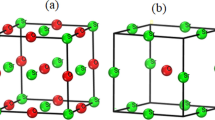Abstract
The adsorption of atomic and molecular nitrogen and ammonia on silicon carbide is considered within two physically different (solid-state and quantum-chemical) approaches. In the solid-state approach, the Haldane–Anderson model is used for the density of states of the SiC 4H and 6H polytypes to demonstrate that the energy of binding to the substrate is 6 and 3 eV for N atoms and N2 molecule, respectively. In the quantum-chemical approach, the model of a surface diatomic molecule is used to find that the binding energy of atomic nitrogen is 6 and 4 eV for adsorption on the C- and Si-edges, respectively. It has been established that the charge transfer between an adsorbate and the substrate may be neglected in all the considered cases. It has been hypothesized that the dissociation of a molecule with the further passivation of its dangling sp3-orbitals with hydrogen atoms takes place for silicon carbide as in the case of ammonia adsorption on Si(100).
Similar content being viewed by others
REFERENCES
Silicon Carbide: Recent Major Advances, Ed. by W. J. Choyke, H. Matsunami, and G. Pensl (Springer, Berlin, Heidelberg, 2004). http://www.springer.de.
Advances in Silicon Carbide. Processing and Applications, Ed. by S. E. Saddow and A. Agarwal (Artech House, Boston, London, 2004). www.artechhouse.com.
A. A. Lebedev, Semicond. Sci. Technol. 21, R17 (2006).
Y. H. Woo, T. Yu, and Z. X. Chen, Appl. Phys. Rev. 108, 071301 (2010).
G. V. Benemanskaya, P. A. Dement’ev, S. A. Kukushkin, A. V. Osipov, and S. N. Timoshnev, Tech. Phys. Lett. 45, 201 (2019).
S. A. Kukushkin, A. V. Osipov, and N. A. Feoktistov, Phys. Solid State 56, 1507 (2014).
S. Yu. Davydov, Adsorption Theory: Model Hamiltonian Method (SPbGETU LETI, St. Petersburg, 2013) [in Russian]; twirpx.com/file/1596114/.
S. Yu. Davydov, A. A. Lebedev, and O. V. Posrednik, An Elementary Introduction to the Theory of Nanosystems (Lan’, St. Petersburg, 2014) [in Russian].
S. Yu. Davydov and S. V. Troshin, Phys. Solid State 49, 1583 (2007).
S. Yu. Davydov and A. V. Pavlyk, Semiconductors 35, 796 (2001).
S. Yu. Davydov and A. V. Pavlyk, Tech. Phys. Lett. 29, 500 (2003).
S. Yu. Davydov and O. V. Posrednik, The Method of Bonding Orbitals in Semiconductor Theory, the School-Book (SPbGETU LETI, St. Petersburg, 2007) [in Russian]; twirpx.com/file/1014608/.
J. P. Xu, P. T. Lai, C. L. Chan, and Y. C. Cheng, Appl. Phys. Lett. 76, 372 (2000).
Y. S. Liu, S. Hashimoto, K. Abe, R. Hayashibe, T. Yamakami, M. Nakao, and K. Kamimura, Jpn. J. Appl. Phys. 44, 673 (2005).
Y. Iwasaki, H. Yano, T. Hatayama, Y. Uraoka, and T. Fuyuki, Appl. Phys. Express 3, 026201 (2010).
F. Liu, C. Carraro, A. P. Pisano, and R. Maboudian, J. Micromech. Microeng. 20, 035011 (2010).
E. Pitthan, A. L. Gobbi, H. I. Boudinov, and F. C. Stedile, J. Electron. Mater. 44, 2823 (2009).
C. Yu. Davydov, Semiconductors 53, 699 (2019).
Physical Values, The Handbook, Ed. by E. S. Grigor’ev and E. Z. Meilikhov (Energoatomizdat, Moscow, 1991) [in Russian].
Tables of Interatomic Distances and Configuration in Molecules and Ions, Ed. by L. E. Sutton (The Chemical Society, London, 1958).
M. D. Ramsier and J. T. Yates, Jr., Surf. Sci. Rep. 12, 243 (1991).
S. Yu. Davydov and S. K. Tikhonov, Phys. Solid State 37, 1514 (1995).
W. A. Harrison, Phys. Rev. B 27, 3552 (1983).
W. A. Harrison, Phys. Rev. B 31, 2121 (1985).
S. Yu. Davydov and O. V. Posrednik, Phys. Solid State 57, 837 (2015).
L. A. Bol’shov, A. P. Napartovich, A. G. Naumovets, and A. G. Fedorus, Sov. Phys. Usp. 20, 432 (1977).
S. Yu. Davydov, Tech. Phys. 59, 624 (2014).
S. Yu. Davydov, A. V. Zubov, and A. A. Lebedev, Tech. Phys. Lett. 45 (5) (2019, in press).
ACKNOWLEDGMENTS
The authors are grateful to S.A. Kukushkin for proposing the topic and useful discussions.
Author information
Authors and Affiliations
Corresponding author
Ethics declarations
The authors declare that they have no conflicts of interest.
Additional information
Translated by E. Glushachenkova
Rights and permissions
About this article
Cite this article
Davydov, S.Y., Posrednik, O.V. On the Adsorption of Gases on Silicon Carbide: Simple Estimates. Phys. Solid State 61, 1490–1493 (2019). https://doi.org/10.1134/S1063783419080109
Received:
Revised:
Accepted:
Published:
Issue Date:
DOI: https://doi.org/10.1134/S1063783419080109



